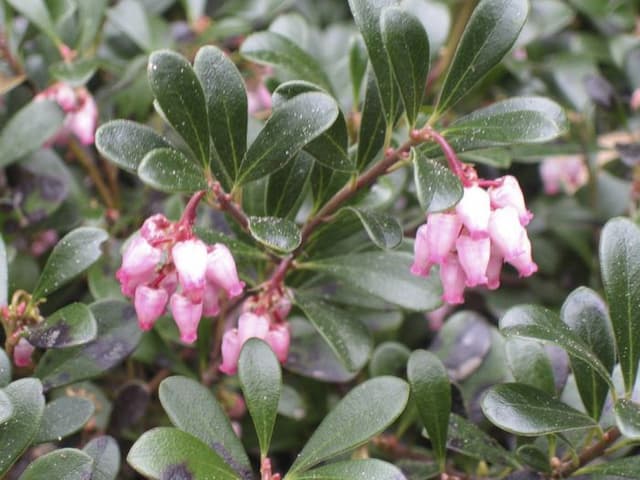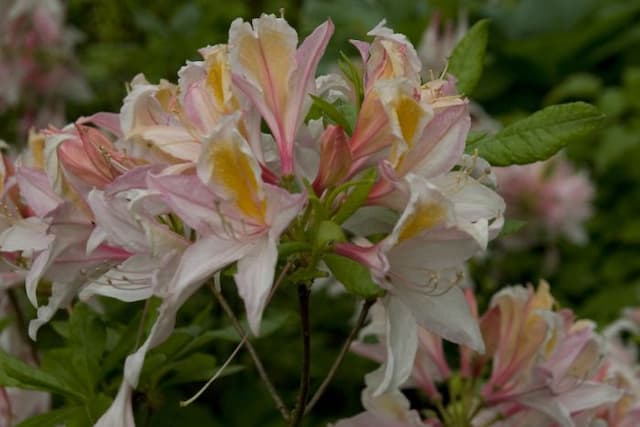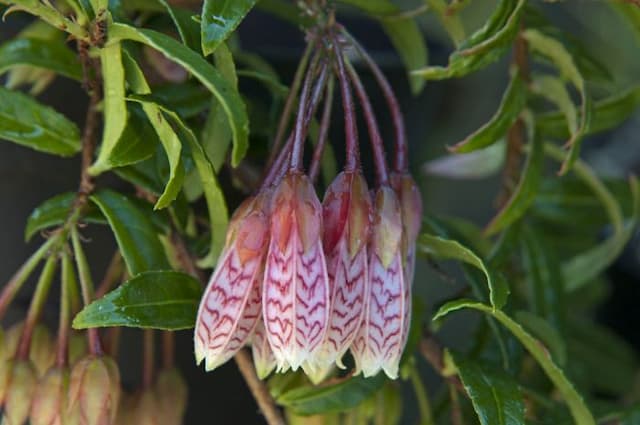Azalea Rhododendron 'Norma' (R/d)

ABOUT
The Rhododendron 'Norma' is a visually striking plant known for its lush, evergreen foliage and vibrant blossoms. Its leaves are a deep, glossy green, providing a rich backdrop for the flowers. The blooms, appearing usually in late spring, are its most captivating feature, with a bold, rosy-pink hue that can range from soft to more intense shades. These flowers are often bell-shaped, with a slight ruffle at the edges, and gather in large, showy clusters known as trusses, which can create a spectacular display contrasted against the dark green leaves. Each individual flower is composed of several petals fused at the base, typical of Rhododendrons, giving the blooms a full, rounded appearance. The plant's overall lushness and the abundant, colorful blossoms make it a favorite for adding a splash of brightness to garden spaces.
About this plant
 Names
NamesFamily
Ericaceae.
Synonyms
Azalea, Rhododendron.
Common names
Rhododendron 'Norma'
 Toxicity
ToxicityTo humans
Rhododendron, including the variety 'Norma', contains toxic compounds that can be harmful to humans if ingested. The plant's leaves, nectar, and flowers all contain grayanotoxins, which can cause poisoning. Symptoms of rhododendron poisoning may include vomiting, diarrhea, hypersalivation, weakness, coma, hypotension, central nervous system depression, cardiovascular collapse, and potentially death if consumed in large enough quantities.
To pets
Rhododendron is toxic to pets, such as dogs and cats. The same grayanotoxins that affect humans are also hazardous to animals, and all parts of the plant, including leaves and flowers, are poisonous if ingested. Symptoms of rhododendron poisoning in pets can include vomiting, diarrhea, drooling, weakness, tremors, seizures, cardiac problems, and potentially death if not treated promptly.
 Characteristics
CharacteristicsLife cycle
Perennials
Foliage type
Evergreen
Color of leaves
Green
Flower color
Pink
Height
6 feet (1.83 meters)
Spread
6 feet (1.83 meters)
Plant type
Shrub
Hardiness zones
5
Native area
Asia
Benefits
 General Benefits
General Benefits- Ornamental Appeal: R/d adds aesthetic value to gardens with its vibrant flowers and lush foliage.
- Wildlife Attraction: Its blooms attract pollinators such as bees and butterflies, promoting biodiversity.
- Shade Tolerance: It can grow well in partially shaded areas, providing landscaping options for shaded gardens.
- Seasonal Interest: R/d offers year-round interest with evergreen leaves and springtime blooms.
- Erosion Control: The plant's root system helps stabilize soil on slopes and prevent erosion.
- Privacy Screen: When planted in a group, R/d can create a dense, natural privacy barrier.
- Low Maintenance: Once established, it requires minimal care, making it suitable for low-maintenance landscapes.
- Cultural Significance: Rhododendrons are often used in celebrations and represent various meanings in different cultures.
- Versatility in Landscaping: Can be used for borders, as a specimen plant, or for mass plantings in larger areas.
- Durability: R/d is generally hardy and can withstand various climatic conditions within its suited zones.
 Medical Properties
Medical PropertiesThis plant is not used for medical purposes.
 Air-purifying Qualities
Air-purifying QualitiesThis plant is not specifically known for air purifying qualities.
 Other Uses
Other Uses- Rhododendon 'Norma' branches can be used in floral arrangements for a rustic and natural look. The branches provide structure and a lush backdrop to other flowers in the display.
- The leaves of the Rhododendron can be pressed and used for botanical art projects, creating natural patterns and designs in collages and other crafts.
- The acidic leaves can be composted carefully to create a mulch ideal for other acid-loving plants in your garden.
- Rhododendron flowers can be used to create natural dyes for textiles, giving fabrics a range of beautiful pink to purple hues.
- The dense foliage can provide a hiding or nesting space for small birds and beneficial insects in your garden.
- Dried rhododendron petals can be incorporated into homemade potpourris, adding color and subtle fragrance to a room.
- Some hobbyists use thinner branches from the Rhododendron for crafting small pieces of furniture or decorative items, as the wood is quite workable.
- During winter, the evergreen Rhododendron can act as a windbreak for smaller, more delicate plants in the garden.
- The visual appeal of Rhododendron 'Norma' can be used in landscape design to create focal points or to add spring color to garden beds and borders.
- Rhododendron flowers can serve as a food source for bees when they bloom, providing essential nectar during the spring season.
Interesting Facts
 Feng Shui
Feng ShuiThe Rhododendron is not used in Feng Shui practice.
 Zodiac Sign Compitability
Zodiac Sign CompitabilityThe Rhododendron is not used in astrology practice.
 Plant Symbolism
Plant Symbolism- Beware: Rhododendrons, due to containing toxic substances, are often associated with caution. The 'Norma' variety carries this symbolism as a gentle warning of the dangers hidden beneath beauty.
- Abundance: With their lush, full blooms, rhododendrons symbolize abundance and wealth, and 'Norma', with its profuse flowers, underscores this symbolism.
- Temperance: The rhododendron is a symbol of moderation or temperance, as it thrives best when sheltered from extreme conditions. 'Norma' inherits this symbolism, representing a balanced and harmonious approach to life.
- Elegance: The striking beauty of the Rhododendron 'Norma' is often associated with elegance and dignity, reflecting its stately appearance.
- Survival: Rhododendrons are known for their ability to survive in challenging climates, and the 'Norma' variety symbolizes the resilience and strength to overcome adversity.
- Homecoming: In certain cultures, rhododendrons are a symbol of returning home or coming back, and 'Norma', with its homely charm, shares in this sentiment of reunion and nostalgia.
 Water
WaterRhododendrons, including 'Norma', prefer consistently moist soil, so they should be watered thoroughly whenever the top inch of soil feels dry to the touch. Typically, this might mean watering once a week, but frequency can vary depending on climate, weather conditions, and soil type. It is important to avoid overwatering to prevent root rot, ensuring the plant is in well-draining soil. In terms of amount, during dry periods, provide about 1 gallon of water per foot of plant height each week. Adjust this amount during rainy seasons or in cooler climates where the soil retains moisture longer.
 Light
LightRhododendrons like 'Norma' thrive best in dappled shade. They often succeed under the canopy of larger trees where they receive filtered sunlight. Direct, harsh afternoon sunlight can damage the leaves, while too much shade can result in poor blooming. An eastern or northern exposure is often ideal, providing the necessary bright but indirect light.
 Temperature
TemperatureThe ideal temperature for the Rhododendron 'Norma' is a range between 50°F and 70°F. These plants can survive minimum temperatures down to about 0°F but can be damaged by frost. Protection from cold winds and proper mulching can help them survive the colder end of the temperature range.
 Pruning
PruningRhododendrons like 'Norma' should be pruned to maintain shape, encourage bushier growth, and remove dead or diseased branches. The best time to prune is soon after the blooming period has ended, which is typically in late spring or early summer. Deadheading, or removing spent flower clusters, can also promote better blooms the following year. Make clean cuts at a 45-degree angle just above a healthy set of leaves.
 Cleaning
CleaningAs needed
 Soil
SoilAzaleas prefer acidic, well-draining soil with a pH between 4.5 and 6.0. An ideal mix would be equal parts peat moss, pine bark, and perlite.
 Repotting
RepottingAzaleas should be repotted every 2-3 years or when root-bound, preferably in the spring after blooming.
 Humidity & Misting
Humidity & MistingAzaleas thrive in high humidity levels, ideally between 60-80%.
 Suitable locations
Suitable locationsIndoor
Keep azaleas in cool area with bright, indirect light.
Outdoor
Plant azaleas in dappled shade with moist, acidic soil.
Hardiness zone
4-8 USDA.
 Life cycle
Life cycleThe Rhododendron 'Norma', commonly known as a type of Azalea, begins its life cycle as a seed, which after germination, grows into a seedling. As the seedling matures, it develops a root system and foliage, entering the vegetative stage. Over time, the vegetative plant grows larger and eventually starts to produce buds, signaling the onset of the reproductive stage. The buds bloom into characteristic flowers, which after pollination, develop into seed capsules containing numerous seeds. Once the seeds are dispersed, the cycle can begin again with new seedlings. Throughout its life, which can span several decades with the right care, the Rhododendron 'Norma' may undergo periods of dormancy, typically in colder months, before resuming growth in the spring.
 Propogation
PropogationPropogation time
Late winter to spring
Rhododendron 'Norma', commonly known as a variety of Rhododendron, is most effectively propagated by semi-hardwood cuttings. The optimal time for taking cuttings is during the late summer months, typically from July to September. To propagate by this method one should select healthy, semi-hardwood stems from the current year's growth. These cuttings should be about 4 to 6 inches (about 10 to 15 centimeters) long, with the lower leaves removed. The cut end of the stem should be dipped into a rooting hormone to encourage root development and then placed into a potting mixture that is well-draining and kept consistently moist but not waterlogged. The pot should be placed in a warm, shaded area, and covered with a plastic bag or put into a greenhouse to maintain high humidity around the cuttings. Roots typically develop within several weeks, after which the new Rhododendron plants can gradually acclimate to outside conditions before being planted in their final location.









